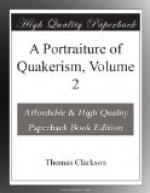But in whatever sense the words “do this in remembrance of me” are to be taken, the Quakers are of opinion, as far as St. Luke states the circumstances, that they related solely to the disciples themselves. Jesus Christ recommends it to those who were present, and to those only, to do this in remembrance of him. But he no where tells them to order or cause it to be done by the whole Christian world, as he told them to “preach the Gospel to every creature.”
To sum up the whole of what has been said in this chapter:—If we consult St. Luke, and St. Luke only, all that we can collect on this subject will be, that the future passover-suppers of Christ with his disciples were to be spiritual; that his disciples were desired to break their bread together in remembrance of him; or if, as Jews, they could not relinquish the passover, to celebrate it with a new meaning; but that this permission extended to those only who were present on that occasion.
SECT. V.
Account of St. Paul—He states that the words “do this in remembrance of me” were used at the passover-supper—That they contained a permission for a custom, in which both the bread and the wine were included—That this custom was the passover, spiritualised by Jesus Christ—But that it was to last but for a time—Some conjecture this time to be the destruction of Jerusalem—But the Quakers, till the disciples had attained such a spiritual growth, that they felt Christ’s kingdom substantially in their hearts—And as it was thus limited to them, so it was limited to such Jewish converts as might have adopted it in their times.
The last of the sacred writers, who mentions the celebration of the passover-supper, is St. Paul, whose account is now to be examined.
St. Paul, in his first epistle to the Corinthians, reproves[187] the latter for some irregularities committed by them in the course of their religious meetings. What these meetings were is uncertain. They might have been for the celebration of the passover-supper, for there was a synagogue of Jews at Corinth, of whom some had been converted. Or they might have been for the celebration of the passover as spiritualized by Jesus Christ, or for the breaking of bread, which customs both the Jewish and Gentile converts might have adopted. The custom, however, at which these irregularities took place, is called by St. Paul, the Lord’s Supper. And this title was not inapplicable to it in either of the cases supposed, because it must have been, in either of them, in commemoration of the last supper, which Jesus Christ, or the Lord and Master, ate with his disciples before he suffered.




